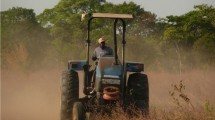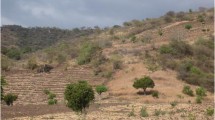Abstract
Agriculture plays a crucial role in global food production. Nevertheless, the concern about its impact on the environment and sustainability is increasing. This article addresses modern technologies that are used or can be used in sustainable agriculture. There are discussions of various technological innovations, including precision agriculture and remote sensing. These innovations have demonstrated the prospects of reducing resource use, increasing efficiency, and improving environmental sustainability in agriculture. The authors also highlighted the problems and limitations of these technologies, such as cost, availability, and possible unintended consequences. In addition, the article discusses the need for interdisciplinary cooperation between researchers, politicians, and farmers to ensure the successful implementation of these technologies in agriculture. In general, the findings emphasize the need for the introduction of technologies in agriculture for sustainable methods and the potential of technologies to contribute to sustainable agriculture in the future.



Similar content being viewed by others
Data availability
Data will be available on request.
References
Abate, T., van Huis, A., & Ampofo, J. K. O. (2000). Pest management strategies in traditional agriculture: An African perspective. Annual Review of Entomology, 45(1), 631–659.
Actualitix. (2022). World atlas. Statistics by country. Retrieved Dec 25, (2022), from https://ru.actualitix.com/ (accessed on 25 December 2022).
Ahmetzhanov, B., Tazhibekova, K., Shametova, A., & Urazbekov, A. (2018). Expanded implementation of solar photovoltaics: Forecasting and risk assessment. International Journal of Energy Economics and Policy, 8(5), 113–118.
Anderson, C. R., Maughan, C., & Pimbert, M. P. (2022). Transformative agroecology learning in Europe: Building consciousness, skills and collective capacity for food sovereignty. Critical adult education in food movements (pp. 11–27). Springer Nature Switzerland: Cham. https://doi.org/10.1007/978-3-031-19400-9_2
Aslan, M. F., Durdu, A., Sabanci, K., Ropelewska, E., & Gültekin, S. S. (2022). A comprehensive survey of the recent studies with UAV for precision agriculture in open fields and greenhouses. Applied Sciences, 12(3), 1047. https://doi.org/10.3390/app12031047
Bagandova, L. M., & Ashuryuekova, T. N. (2011). Current status of the problem of environmental analysis of biomonitoring and bioindication of anthropogenic impacts. South of Russia: Ecology, Development, 3, 96–99.
Barbedo, J. G. A., & Koenigkan, L. V. (2018). Perspectives on the use of unmanned aerial systems to monitor cattle. Outlook on Agriculture, 47(3), 214–222. https://doi.org/10.1177/0030727018781876
Benyam, A., Kinnear, S., & Rolfe, J. (2018). Integrating community perspectives into domestic food waste prevention and diversion policies. Resources, Conservation and Recycling, 134, 174–183. https://doi.org/10.1016/j.resconrec.2018.03.019
Bezner Kerr, R., Rahmanian, M., Owoputi, I., & Batello, C. (2019). Agroecology and nutrition: Transformative possibilities and challenges. Sustainable Diets Lining Nutrition and Food Systems Wallingford, CABI (pp. 53–63). Wallingford, UK/Boston, USA: CABI.
Calicioglu, O., Flammini, A., Bracco, S., Bellù, L., & Sims, R. (2019). The future challenges of food and agriculture: An integrated analysis of trends and solutions. Sustainability, 11(1), 222. https://doi.org/10.3390/su11010222
Campbell, B. M., Beare, D. J., Bennett, E. M., Hall-Spencer, J. M., Ingram, J. S., Jaramillo, F., & Shindell, D. (2017). Agriculture production as a major driver of the Earth system exceeding planetary boundaries. Ecology and Society, 22(4), 8.
European Commission. (2022). Official web site. Retrieved Dec 25, (2022), from https://ec.europa.eu/eurostat/statistics-explained/index.php?title=Agri-environmental_indicator_-_consumption_of_pesticides
Agroecology Europe. (2017). Our understanding of agroecology. Retrieved Decr 25, (2022), from http://www.agroecology-europe.org/ourapproach/our-understanding-of-agroecology/
European union. (2019). Agriculture, forestry and fishery statistics. Publications Office of the European Union.
FAO. (2019). The state of food security and nutrition in the world 2019. Building climate resilience for food security and nutrition. FAO: Rome. Retrieved Dec 25, (2022), from http://www.fao.org/3/I9553EN/i9553en.pdf
FAO. (2022). Food and agriculture organization of the United Nations. FAO: Rome. Retrieved Dec 25, (2022), from http://www.fao.org/faostat/en/#data/QA/visualize
Federal State Statistics Service. (2022). Official web site. Retrieved Dec 25, (2022), from https://gks.ru/bgd/regl/b19_38/Main.htm
Fitton, N., Alexander, P., Arnell, N., Bajzelj, B., Calvin, K., Doelman, J., Gerber, J. S., Havlik, P., Hasegawa, T., Herrero, M., Krisztin, T., van Meijl, H., Powell, T., Sands, R., Stehfest, E., West, P. C., & Smith, P. (2019). The vulnerabilities of agricultural land and food production to future water scarcity. Global Environmental Change, 58, 101944. https://doi.org/10.1016/j.gloenvcha.2019.101944
Joshi, L., Shrestha, P. K., Moss, C., & Sinclair, F. L. (2004). Locally derived knowledge of soil fertility and its emerging role in integrated natural resource management. Below-ground interactions in tropical agroecosystems: Concepts and models with multiple plant components (pp. 17–39). CABI Publishing.
Liu, X., Yuan, Z., Liu, X., Zhang, Y., Hua, H., & Jiang, S. (2020). Historic trends and future prospects of waste generation and recycling in China’s phosphorus cycle. Environmental Science & Technology, 54(8), 5131–5139. https://doi.org/10.1021/acs.est.9b05120
Meyfroidt, P., Schierhorn, F., Prishchepov, A. V., Müller, D., & Kuemmerle, T. (2016). Drivers, constraints and trade-offs associated with recultivating abandoned cropland in Russia, Ukraine and Kazakhstan. Global Environmental Change, 37, 1–15. https://doi.org/10.1016/j.gloenvcha.2016.01.003
Moran, D., & Blair, K. J. (2021). Sustainable livestock systems: Anticipating demand-side challenges. Animal, 15, 100288. https://doi.org/10.1016/j.animal.2021.100288
Mustafa, M. A., Mabhaudhi, T., Avvari, M. V., & Massawe, F. (2021). Transition toward sustainable food systems: A holistic pathway toward sustainable development. In Food security and nutrition (pp. 33-56). Academic Press. https://doi.org/10.1016/B978-0-12-820521-1.00002-2
OECD library. (2022). Official web site. Retrieved Dec 25, (2022), from https://www.oecd-ilibrary.org
Pimbert, M. P. (2018). Global status of agroecology. Economic & Political Weekly, 53(41), 52–57.
Rastgoo, M., & Hasanfard, A. (2021). Desertification in agricultural lands: Approaches to mitigation. in deserts and desertification. IntechOpen.
Solgi, E., Sheikhzadeh, H., & Solgi, M. (2018). Role of irrigation water, inorganic and organic fertilizers in soil and crop contamination by potentially hazardous elements in intensive farming systems: Case study from Moghan agro-industry Iran. Journal of Geochemical Exploration, 185, 74–80. https://doi.org/10.1016/j.gexplo.2017.11.008
World Data Atlas. (2022). Official web site. Retrieved Dec 25, (2022), from https://knoema.ru/atlas/topics
Acknowledgements
Svetlana Germanova has been supported by the RUDN University Strategic Academic Leadership Program.
Funding
This research did not receive any specific grant from funding agencies in the public, commercial, or not-for-profit sectors.
Author information
Authors and Affiliations
Corresponding author
Ethics declarations
Competing interests
The authors declare that they have no competing interests.
Consent to participate
Not applicable.
Consent for publication
Not applicable.
Ethics approval
Not applicable.
Additional information
Publisher's Note
Springer Nature remains neutral with regard to jurisdictional claims in published maps and institutional affiliations.
Rights and permissions
Springer Nature or its licensor (e.g. a society or other partner) holds exclusive rights to this article under a publishing agreement with the author(s) or other rightsholder(s); author self-archiving of the accepted manuscript version of this article is solely governed by the terms of such publishing agreement and applicable law.
About this article
Cite this article
Germanova, S., Kondrashev, S. & Lazareva, Y. Minimizing the adverse effects of agriculture on the environment: the case of Russia. Environ Dev Sustain (2023). https://doi.org/10.1007/s10668-023-03366-y
Received:
Accepted:
Published:
DOI: https://doi.org/10.1007/s10668-023-03366-y




